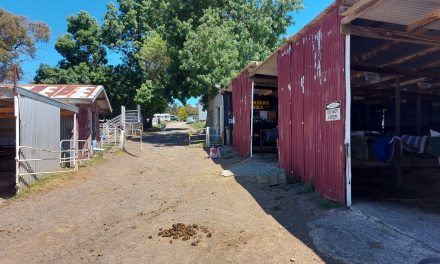We Need Your Support
It’s that time – when we ask you to make a donation to support the Wombat Post.
We are a volunteer, community-run news service for Hepburn Springs and Daylesford. Last year we published more than 500 local stories, maintained a local events calendar and a local business and services directory. We depend on local support to meet our costs. We have a group of loyal members that support as as well and you could always join them, if you haven’t already.
Tanya Loos
The pobblebonk or eastern banjo frog is a rather large frog, with a huge head and stout legs. The pobblebonks resonant “bonk” call can be heard all over the Hepburn Shire in spring.
When a group of males calls, they “bonk” at slightly different pitches, creating a lovely chorus.
Pobblebonks are burrowing frogs that are very common in our gardens. They spend the day buried in the soil, under logs or bits of tin, then come out to feed on insects at night.
I came across a pobblebonk when moving a large pile of sandstone rubble that had been sitting there for over a year. I was so relieved my shovel didn’t break him in half. He or she was covered in clay dust, and I carefully put the frog in a garden bed, covered in a layer of clay and gravel so a currawong didn’t spot him.
Pobblebonks change their habits when breeding season comes with the rain. They leave their burrows and migrate up to a kilometre to a water body such as a dam, or slow moving section of creek. Then the chorus begins.

Pobblebonk foam nests. (Photo: Margaret Hodge)
Pobblebonks are in a group of frogs called the genus Limnodynastes, and all 12 species are well known for their characteristic foam nests. The nests look like someone has done some washing up in the vegetation at the side of the dam and the bubbles have stayed there.
On closer inspection, the bubbles are actually a kind of bubbly jelly, which contains the frog eggs. When the frogs are mating, the female pobblebonk raises her hands to the surface of the water and makes four to six broad breast strokes, which help her trap the air bubbles in the frog egg jelly. The female frog has special flaps of skin on her fingers, which assist in this process.
The tadpoles are large and dark coloured, and in cool areas such as the Hepburn Shire, can take over a year to mature into young frogs. These frogs require permanent water for their breeding efforts to succeed.
Interested in learning more about our local frogs? Check out the Australian Musuem’s fantastic Frog ID project.

A pobblebonk “bonking”. (Video: Margaret Hodge)
Tanya Loos is a local naturalist, author and environmental consultant who loves to work in the environmental not-for-profit sector. She is the author of “Daylesford Nature Diary” available from her website or from Paradise Books in Vincent Street, Daylesford.
This article was originally printed in the True Spring chapter in “Daylesford Nature Diary: Six Seasons in the Foothill Forests” published by em PRESS and available at Paradise Books in Vincent Street Daylesford.
Have you got any nature questions for Tanya? Send them in!













